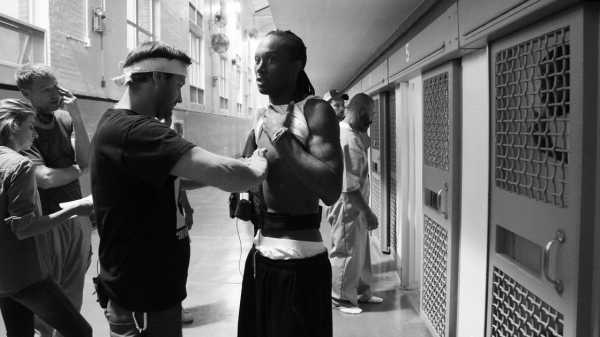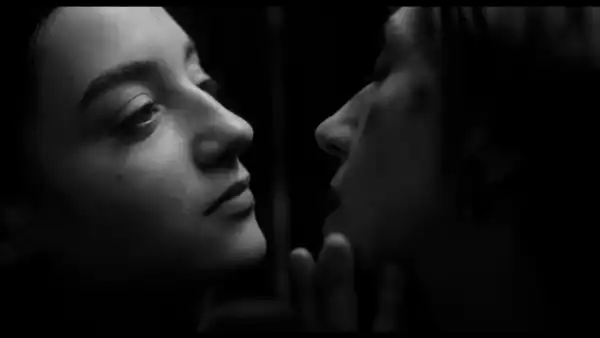
The film “O.G.,” set and shot in a prison in Indiana, using inmates and guards as cast and crew, had its première on Friday night, as part of the Tribeca Film Festival.
I visited the production for six days, in 2016, for a piece that ran in The New Yorker a few months ago. That was the first extended time I’d ever spent on a movie set, or inside a prison, for that matter, so I found it hard, seeing the finished film the other night, to take stock of it in the way one usually might. I was too mesmerized by this encounter, on screen, with so many of the inmates I’d met (and developed a fondness for) and with the place itself—Pendleton Correctional Facility, a maximum-security state penitentiary outside Indianapolis, which is, in its way, as vivid a character in “O.G.” as the submarine was in “Das Boot.” Nonetheless, I feel I can reliably state that the performances are exceptionally strong, both by the free-to-leave professional actors (especially Jeffrey Wright, who plays Louis, the “O.G.” of the title, an older inmate on the verge of release) and by the incarcerated neophytes.
Madeleine Sackler, the director, invited relatives of a few prisoners who appear in the film to attend the première. One of these was Talishia Collier, the mother of Theothus Carter, Jr., whose father, Theothus Carter, is serving a sixty-five-year sentence at Pendleton for armed burglary and attempted murder. In “O.G.,” Carter plays the role of Beecher, a young agitator and an acolyte of sorts to Louis. Among the inmates, he has the biggest role. He amazed the filmmakers with his aptitude and devotion. His experience on the film was a highlight of his life, he told me, second only to the existence of his son.
But, just two weeks after shooting wrapped, in the summer of 2016, Theothus, Jr., the son, was shot and killed at a gas station in Indianapolis. He was sixteen. The murder remains unsolved. His father, meanwhile, soon ran into trouble at the prison, and has spent the past year and a half in and out of the solitary-housing unit, also known as the SHU or the hole. (As such, he often was deprived of telephone or in-person contact with anyone outside the prison. To fact-check the material pertaining to him in my story, we had to communicate with him by mail.)
I met up with Collier before the screening. She and a half-dozen other family members had flown in that afternoon and were waiting by the red carpet. The production was putting them up for a night at a Hilton near Times Square. She had on peach-colored stretch pants, a sheer black blouse, and a black leather jacket. She said she still talks to Carter regularly. “But he’s in the hole now. Ever since he played a role in this movie, they’ve been messing with him, seems like for no reason.” It’s hard to know why this would be the case, but the prison’s social economy is pretty inscrutable to the likes of me. (As it happens, I received a letter from Carter this week, handwritten in neat script on official Pendleton stationery and dated April 10th. “I’ve been in Segregation since Aug 25th 2017. I’ve been on phone restriction, kiosk restriction and commissary restriction for 5 months so I haven’t heard my family voices since November 11th 2017.” It went on, “They’ve been punishing me every step of the way because of my participation in this movie.” Even so, he wrote, he would do it all again.)
Collier lives in East Indianapolis. Before her son was killed, she had been working as an intake specialist at a community center, but she hasn’t been back since. She says she needs medical clearance to return, but her doctor won’t grant it. “I have all these dreams of my son, where we’re laughing and playing,” she said. “The doctor, he thinks I’m just hallucinating.” She told me that her grandmother died in February and her cousin was shot and killed in March. “But I’m hanging in there.”
She and Carter met when she was fifteen and he was sixteen. Their son, born two years later, grew up visiting his father at various penitentiaries. When Carter, got to Pendleton, mother and son went a couple years without seeing him, because Collier’s own father was already an inmate there, too; she was on his visitor list, and no one was allowed to be on the list of more than one inmate at a time. It took a while, she said, for her father to take her off his list. After that, they came to see Carter regularly. (Wright met them during the movie shoot.)
But she had never been past the visiting area, which is just inside the first series of gates at Pendleton. Once the film began, on Friday night, Collier, sitting in the audience with a friend from home, watched as the cameras took her, for the next couple of hours, inside the place she’d only imagined. “It was weird,” she said afterward. “Board of Health needs to go in there. Doesn’t look too healthy or safe. Him living like this, that was sad to me.” (Trivial though it may seem, it’s jarring to think that these men don’t ever get to show their families, in person or in photographs, where or how they live.)
Carter had been telling Collier about his turn as an actor. “He said he was good at it, but I didn’t believe him,” she said. “He said he could make himself cry.” There’s a scene in the film where Carter sheds tears, and when Collier saw it, she put her head in her hands and began to cry too, mainly because he looked so much like their son. “Seeing my son up there on this big old screen, that hit me,” she said. “I just wish he was here to see it. He was so excited. He got to meet Jeffrey Wright and all that.”
If she had to name a favorite scene, she thought it might have been one in which some black guys are giving a white guy guff for talking like a black guy, while they’re in the rec area playing pool. “ ‘Yo.’ ‘Sheeeeit.’ That was funny,” she said. “But I loved the whole movie. If it comes out on Netflix, I’ll just keep watching it.”
After the credits (which contain a note that Theothus Carter had dedicated his performance to his son), Sackler led some of the producers and actors, including Wright, onto the stage. Behind them, three inmates appeared on screen, FaceTiming from Pendleton. There ensued a discussion, with questions from the audience, about their lives in prison and the making of the film. The three incarcerated men, all of whom had speaking parts in the film and were also involved in the making of a documentary about some of the inmates’ lives (“It’s a Hard Truth Ain’t It,” which has its première Wednesday night), were dressed in jumpsuits—their browns—and looked both delighted and bemused to be on a giant screen in Manhattan. The man in the middle, wearing wraparound sunglasses, as he had been whenever I saw him at Pendleton (he does his scene in “O.G.” without them), was Charles Lawrence, an easy-going middle-aged guy who is serving a sentence of a hundred and twenty years, for murder.
“Is my wife there?” he said. She was: Sonya Lawrence. She could see him, but he couldn’t see her. He waved. She called out, and as the conversation came to an end he leaned in toward the camera, looming large, and made a gesture as though to give her a hug. And then the three men disappeared from the screen. The theatre emptied out, to make way for the next film, a love story called “Duck Butter.”
Sourse: newyorker.com






